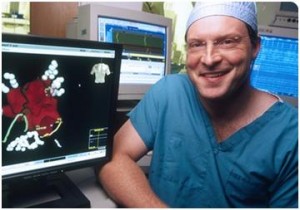Clinical
CLINICAL: Cardiovascular Medicine
- Highlight: Clinical Leadership
- Highlight: Giving Patients a Change of Heart
- Highlight: Procedure Stats
The UVA cardiovascular program has continued to build its national reputation while expanding areas of excellence and innovation, increasing patient access to providers, and strengthening its focus on quality and safety. Cardiovascular physicians perform the largest volume of angioplasties of the superior mesenteric artery in the country. An expanded percutaneous valve program has gained national-level recognition, and the acquisition of a robotic catheter system, the Sensei, has made it easier for electrophysiologists to maneuver catheters into difficult-to-reach places in the heart. Faculty additions in vascular medicine (non-invasive and interventional) have positioned the division for growth in this core service line; an urgent care clinic has eased access to cardiovascular physicians by allowing acute heart patients to bypass the emergency department; and UVA’s new outpatient clinics to the north, east and west of Charlottesville have expanded the division’s clinical footprint.
 Adding to other notable “firsts” from the division, in June 2013 the Electrophysiology (EP) Lab and Atrial Fibrillation (“Afib”) Center announced the first successful procedure in central Virginia for left atrial appendage (LAA) occlusion using the LARIAT device. The procedure, performed by division faculty Drs. Ferguson, DiMarco, Mangrum, and Hussain, was a multidisciplinary effort that included personnel from Anesthesia, Critical Care, the OR, and the Cardiac Catheterization and Echo Labs. The manufacturer of the LARIAT device, SentreHeart, provided technical support. Atrial fibrillation, a condition in which the heart beats irregularly (either too fast or too slow), affects an estimated 3 million people in the U.S. and leads to a fivefold increase in risk for stroke. The minimally invasive LARIAT procedure reduces this risk for patients who are unable to take blood thinning medications; a loop stitch is placed around the base of the LAA that permanently seals it off from the rest of the heart and blocks stroke-causing blood clots from traveling to the brain.
Adding to other notable “firsts” from the division, in June 2013 the Electrophysiology (EP) Lab and Atrial Fibrillation (“Afib”) Center announced the first successful procedure in central Virginia for left atrial appendage (LAA) occlusion using the LARIAT device. The procedure, performed by division faculty Drs. Ferguson, DiMarco, Mangrum, and Hussain, was a multidisciplinary effort that included personnel from Anesthesia, Critical Care, the OR, and the Cardiac Catheterization and Echo Labs. The manufacturer of the LARIAT device, SentreHeart, provided technical support. Atrial fibrillation, a condition in which the heart beats irregularly (either too fast or too slow), affects an estimated 3 million people in the U.S. and leads to a fivefold increase in risk for stroke. The minimally invasive LARIAT procedure reduces this risk for patients who are unable to take blood thinning medications; a loop stitch is placed around the base of the LAA that permanently seals it off from the rest of the heart and blocks stroke-causing blood clots from traveling to the brain.
The division’s quality and safety initiatives in the past year included a “Hospital to Home” program that focuses on reducing heart failure readmissions through expanded efforts to educate patients and monitor them after discharge. The division participates in many national registries – for example, the CathPCI Registry, which tracks treatment and outcomes for patients who undergo cardiac catheterizations and/or percutaneous coronary interventions (PCI) procedures. Currently the division is at or above the 90th percentile among U.S. hospitals for a number of NCDR Cath/PCI Registry metrics. The division has many internal, multidisciplinary quality groups, such as the Acute Coronary Syndrome Quality Support Team, comprised of representatives from the emergency department, invasive interventional cardiology, pharmacy, acute care units, and other areas. The division sponsors a monthly presentation, open to all hospital staff, in which cases are examined to determine if opportunities exist for treatment or procedural improvements.
